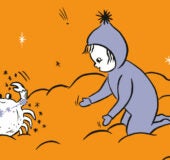INTRODUCTION
A Scandinavian winter is a long and frosty affair. It requires fierce resolve to brave the angry winds that gust inland from the ocean; to enjoy a few pale hours of sun before it slips beneath the horizon once more; to thrive in spite of adversity.
But it’s more than a courageous heart and thick woolen socks that see Scandinavians joyfully through the dark, bleak season. Their spirits are enriched and hearts made buoyant by the concept of hygge (“hue-guh”). It’s their winter elixir. It’s the notion that taking care of yourself and those you love fortifies you with an invincible sense of well-being that no amount of snow or endless twilight can temper.
Loosely translated, the word hygge means “coziness,” but for Scandinavians it means more than creating a warm and inviting space to live. It’s about feeling cozy from the inside out and letting this sense of utter contentment permeate everything you encounter throughout the day, gloomy and gray as it may be. The word originated in Denmark, but the concept is fundamental to how all Scandinavian people live every day of the year. It’s a concept that feels just right during the winter, but one they also carry into the warmer months, when they spend long summer days hiking in forests and invite friends ’round for outdoor barbecues under a midnight sun.
Hygge is about creating a sanctuary of warmth and coziness that acts as a refuge for you and everyone you love. Inviting comforting elements into your day-to-day life is the essence of hygge. Grace, simplicity, and gratitude are the principles hygge practitioners adhere to for an abiding sense of well-being. The Scandinavian spirit overflows with hygge. Drinking hot spiced wine while wrapped in blankets by a glowing fire is hygge. A candlelit meal of warm comfort food with friends is hygge. A summer festival celebrating the longest day of the year with blazing campfires and live music is hygge. Wool socks, aromatic tea, and a good read at a cabin are hygge. A bakery with freshly baked bread is hygge. Bikes are more hygge than cars. Fluorescent lights are never hygge. Relaxing on the couch with a birch schnapps cocktail, your feet kept toasty nestled in the fur of a loving dog, is hygge.
Ultimately, hygge is meant to be felt. It’s the art of creating intimacy and the comforting sense of togetherness in a candlelit room with a fire crackling and cheerful music playing in the background. It’s about eschewing an abundance of material possessions for wealth derived from friendship and solidarity. It’s about inviting friends for a picnic beside a river glistening in the summertime sun. It’s about taking care of your body through exercise that is not viewed as a burden but is enjoyed in the company of friends along a meandering woodland path. It’s about reveling in solitary moments spent reading a book while sipping a good cup of tea. Hygge means slowing down to capture a moment and to listen intently to the stories our loved ones have to share. In the springtime, hygge practitioners gather around outdoor tables flooded in sunshine to make merry over homemade sausages and a few rounds of beer.
The knowing hygge heart is light and gracious. It’s filled with the wisdom of lifelong learning and the compounded gratification of tending others, from our tiniest babies to our oldest and frailest elders to our precious planet. It’s also about caring for ourselves.
Hyggeligt is the adjectival form of hygge, and the word appears frequently in conversation in a region where, when the grip of winter is strongest, the sun never rises at all. Hygge finds its way into decorating, traveling, entertaining, and cooking. Homes in Scandinavia are decorated to look and feel hyggeligt with soft lighting, natural fibers, warm colors, and cozy blankets and pillows strewn all around.
It’s hyggeligt to road trip with a group of friends instead of traveling alone. Staying in instead of going out is hyggeligt; if you do go out, you go to a place with a hyggeligt vibe where the lights are low, the food is comforting, and the conversations easy and relaxed. Hyggeligt dressing is about relaxed comfort, not sequins or scratchy fabrics.
There are events that inspire hyggeligt feelings, such as an orchestra playing classical music beneath a canopy of stars, the audience sitting on woolen rugs in hand-knitted socks, cups of hot cocoa in hand. Simple, slow-cooked meals, with flavors and ingredients that remind guests of their favorite childhood memories—that’s the hygge way to cook. Creating atmosphere with retro tunes—that’s the hygge way to entertain.
Hygge is about making time to pause and be grateful, taking a deep breath, turning off your gadgets, and listening to what nature has to tell you. It’s about absorbing the laughter of your children and meaningfully listening to the stories our elders want to share with us. There is hygge wisdom to be gained there. It’s about self-care and not feeling guilty about it. Loving ourselves is the first step to living the hygge life.
To truly embody the hygge lifestyle, you need to embrace its principles through each passing season in every aspect of your life. Certainly a relaxed cocktail party or cozy afternoon book club on a winter’s day is prime hygge territory, but hygge can be applied to the office, too. The hygge workspace is organized and inviting, free from distractions but rich in inviting atmosphere. It’s a place to accomplish meaningful work that gives you a sense of achievement and pride.
Copyright © 2017 by Gunnar Karl GÃslason and Jody Eddy. All rights reserved. No part of this excerpt may be reproduced or reprinted without permission in writing from the publisher.













